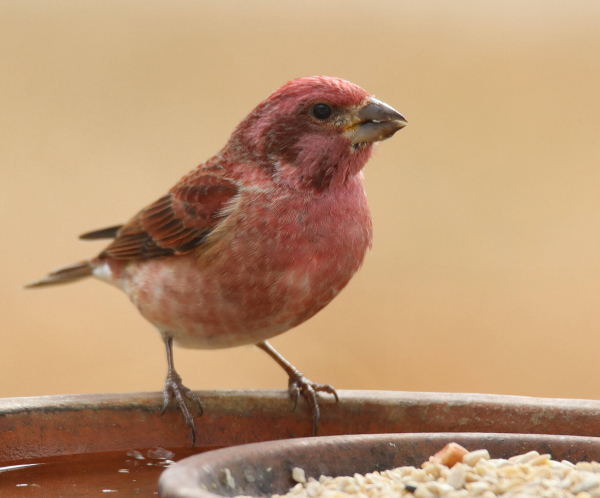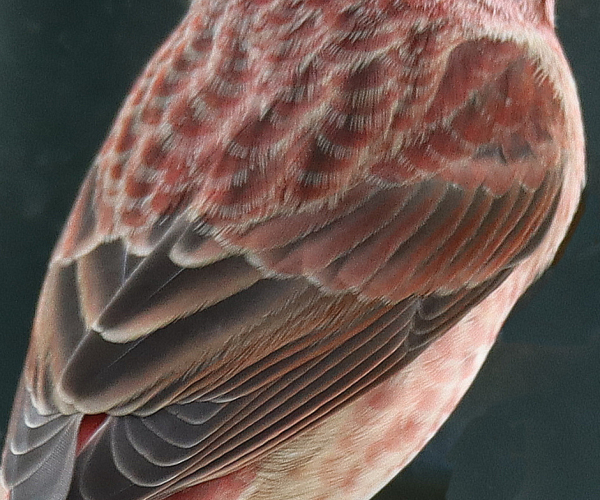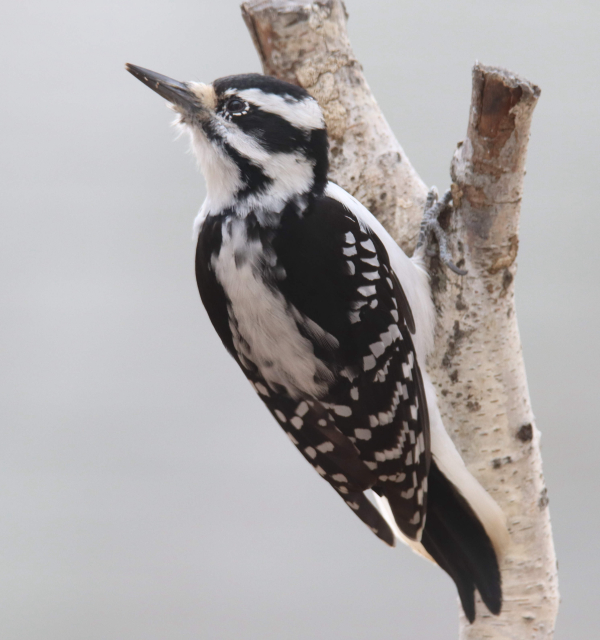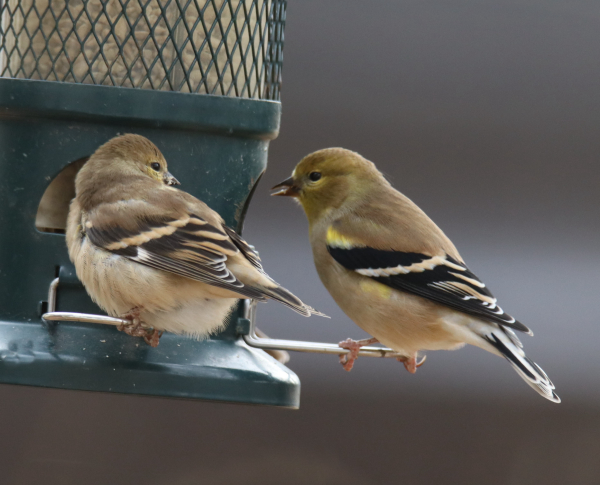
A brightly colored Purple Finch provided inspiration for this article about using your binoculars, and camera, to take a closer look at the birds that appear outside your windows.

Binoculars provide a closer look at birds, their feathers, and their colors.

A trio of Hairy Woodpeckers visited the feeding station, providing this photo of a young female.

A pair of American Goldfinches added to the excitement of new birds visiting the feeders; using your binoculars to get closer looks at birds, and your camera to document the birds out your windows will always add to our backyard experiences.
|
When a colorful male Purple Finch arrived at my feeding station Saturday afternoon, its colors made me interrupt my writing and view it through my 8x binoculars – Wooo! It revealed distinctive outlines to individual feathers and color patterns in its plumage ranging from red to pink to brown and white that fascinated me to the point of writing this reminder for you to use your binoculars to view birds out your windows and as they visit your feeders and bird bath. The degree of magnification of individual feathers and feather groups revealed such detail it really makes you look at each species in a renewed way.
I’ve actually been using my binoculars to view birds at nearby branches and feeders for about 5 months, having fallen out of the practice for a while. I guess it was the deep colors of the male Baltimore Orioles of summer along with the variability of the females that got me started, and lately I’ve been enjoying closer looks at Blue Jays and woodpeckers. And right on que, a male Hairy Woodpecker flew in to provide a close binocular view as it grasped the trunk of an adjacent ash tree, then transferred to a hanging suet feeder – until a Blue Jay barreled in to collect shelled seeds and peanuts, providing a flash of blue, trimmed with black and white highlights – all the more detailed with the magnification of a binocular view.
This is where our emphasis on 8x binoculars, or even 7x binos, really makes sense; it will underline the fact that it’s much easier to hold these regular binoculars steady and get a full view of the birds. Binoculars with 10x and greater magnifications have smaller viewing areas, and it’s harder to hold them steady, which doesn’t improve your view, especially at close quarters with birds out your window. It’s not just me, optics professionals will always suggest sticking with 8x magnification for binoculars.
You can always do your own test comparing these features at a sporting goods store or another outlet; but keep in mind, the person behind the counter may not be a birder, and may not even be in the know about binocular optics. While you’re checking binocular quality, observing birds at close quarters at your feeders is one of the few examples of when the close focus qualities of binoculars come into play. A close focus of 6 feet seems to be becoming a standard for many binocular models, but it’s hard to imagine needing binoculars to view a bird closer than 6 feet. One more observation: I always shy away from mini-binoculars, unless you are putting them in a purse or briefcase or tool box so you have them at work or on the go. You will always benefit from using full-sized binoculars – at home or in the field.
A Second Option?
That brings up the idea of whether you want to use your favorite binoculars as your in house and in the field optics, or whether you opt for a second binocular to use exclusively in house. I appreciate having a pair within reach at my desk and next to my favorite easy chair; while having another pair to use in my car. This option eliminates carrying the binos back and forth, but I did this for quite a while before adding a second binocular.
Certainly, I carry my other optics back and forth – my camera and lens – to keep them within reach too. It’s always fun to document some of the birds as they appear at your feeding station or nearby landscaping elements. In fact, I took the photos that illustrate this article while I wrote it Saturday afternoon, and I would encourage you to have a camera at ready along with your binoculars in a similar manner. It’s really all about getting the most out of our “through the window” experiences as fall transitions to winter, especially in our northern climes.
As I was finishing writing this article, a pair of American Goldfinches interrupted me – that’s a good thing, especially when I haven’t seen a goldfinch at my feeders for months. And as I took a few photos of the goldfinches, a trio of Hairy Woodpeckers arrived to add a flurry of activity at the feeders and adjacent ash tree. Even though the birds are close enough for enjoyable views, observing them and their interactions through binoculars really adds another dimension to the sightings – as evidenced by the return of the Purple Finch – the inspiration for this article. Enjoy all the birds that assemble outside your windows!
Article and photos by Paul Konrad
Share your backyard birding experiences and photos with The Birding Wire at editorstbw2@gmail.com